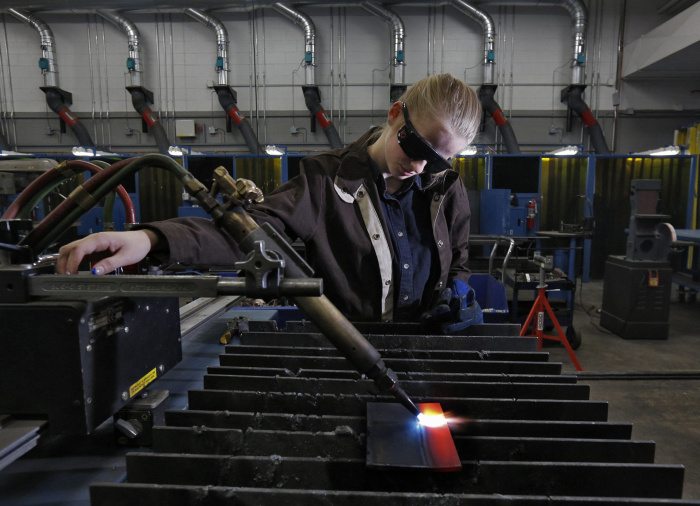By Dean Narciso
The Columbus Dispatch, Ohio.
DELAWARE, Ohio
Strapped into her safety harness, Savannah Adkins clasped the buckle of her lineman’s belt, dug her boots into the pole and began her ascent.
The 17-year-old Galena resident and senior at the Delaware Area Career Center likes tough, outdoor work. And she likes climbing, whether up a pole or toward success in a field traditionally dominated by men.
“More girls are starting to realize they can do these jobs,” Adkins said, “and they want to prove that they can do the same job as men.”
As a journeyman, a line worker earns up to $40 an hour, she has been told. And the two years of class and fieldwork “sets you up to get the career.”
Women entering male-dominated fields hear about gender gaps in pay, discrimination and rigors of physically demanding jobs. And most take it in stride.
Their instructors even prepare them for it.
“No guy would ever climb with a pink jacket,” said Mike Lewis, an instructor in Adkins’ power-line technology class, using humor to illustrate long-held beliefs that girls should avoid dangerous jobs.
Related story: Ohio website promotes construction careers amid worker shortage
Welding appears to be another one of the more popular choices in central Ohio.
The Career and Technical Education Centers of Licking County has four female welding students. In previous years, there weren’t any. The Eastland-Fairfield Career and Technical Center reported that the number of girls enrolled in building and mechanical trades and welding has more than doubled in three years. Delaware’s program had no female welding students five years ago. Today it has three.
One of the Delaware welding students is Megan Stark, 17, who grew up around boys in her Westerville home, playing basketball, baseball, soccer and football.
“I was so much of a tomboy, people couldn’t tell I was a girl,” Stark said.
Her 100-pound frame belies a mental toughness that surprises people.
“Every time I tell someone I’m in a welding lab, they just look at me.
“I look little, but I’m actually pretty strong. You have to be tough and be one of the boys,” she said after dipping glowing steel into a cooling bath.
Stark’s instructor, Brad DeMent, said diversity in the workplace drives demand for females.
“If they come through the training, they’re almost guaranteed to get a job,” he said.
Federal laws have helped strengthen vocational education programs, but stereotypes about dead-end jobs persist, experts say.
“For sure there are some programs doing a very good job attracting females into nontraditional jobs,” said Steven DeWitt, deputy executive director for the Virginia-based Association for Career and Technical Education.
“Generally, it has been challenging for schools. A parent may not want their daughter to be a welder. It’s very difficult for a school to fight that.”
But girls, DeMent said, are welcomed and might even have an edge.
“They’re more about quality than quantity, more fine-tuned, and pay attention to the details.”
Some girls in rural Delaware County want skills to help them on the farm. Others simply want a broad range of skills.
Brooke Mack is learning how to repair tractors and car engines, and excited to become self-sufficient.
“We’re stereotyped to not do this kind of thing,” said Mack, of Ostrander. “The girls who want to do it but were afraid are now more willing.”














































































































































































































































































































































































